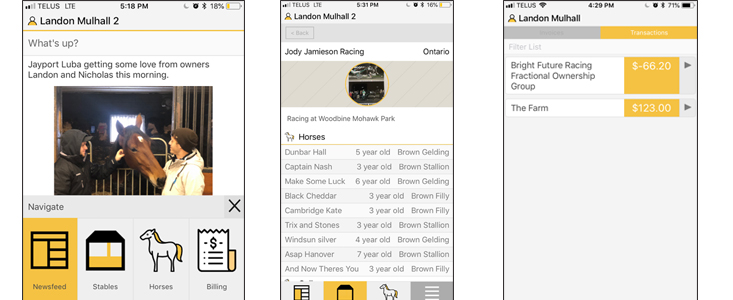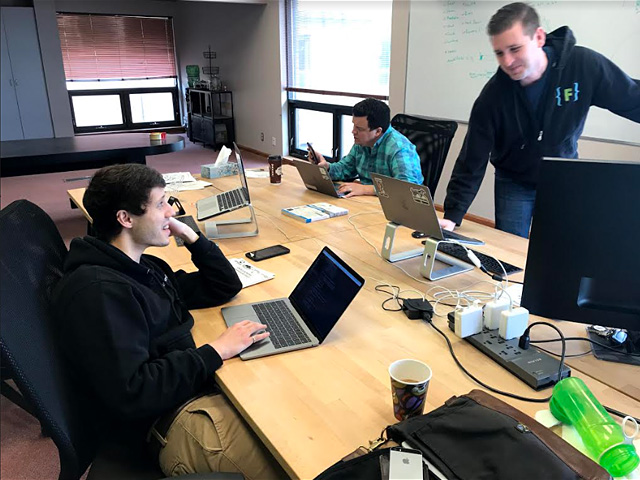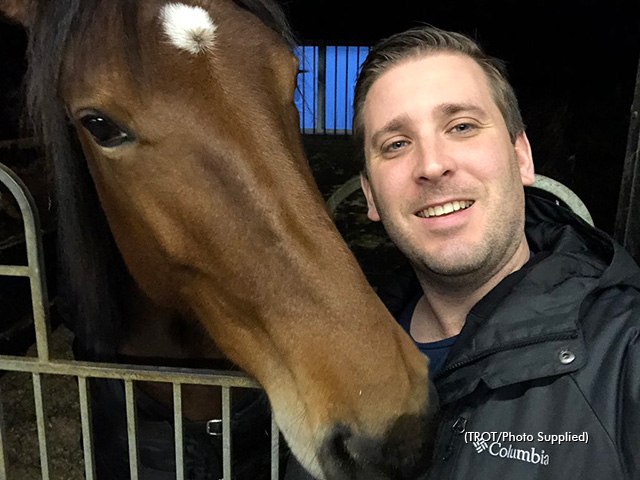Ryan Clements, and his team from The Farm Ventures, the creators of Off & Pacing and Catch Driver, are developing a new app called Bright Future - something that will make the life of a trainer much easier.
By Melissa Keith

Ryan Clements is one of harness racing’s innovators. His company, The Farm Ventures, develops phone games and apps from headquarters at Uxbridge, Ontario’s Prince Lee Acres. If you’ve ever played Catch Driver or Off and Pacing, you are familiar with The Farm Ventures’ wildly successful harness racing games.
In 2015, Clements interviewed for a technical position at Google; while he did not land that particular job, a company rep encouraged him to apply for others because he was “very Googley.” The now-32-year-old developer founded his own start-up instead, bringing together his tech background and lifetime love of harness racing. Stable management game Off and Pacing sprinted off the starting gate in 2017, winning players from around the globe, some with harness racing experience, some without. Catch Driver debuted in 2018, offering gamers the opportunity to drive harness horses in virtual races. A new Thoroughbred stable management game, Turf Dynasty, was being developed by The Farm Ventures at press time.
His recent success has now allowed Clements to revisit the first digital racing product that he launched over a decade ago - Online Harness Owner, which began promoting fractional ownership through digital stable records management around 2005. “We created that because I didn’t have any money and I wanted to own horses,” he shares. “So basically my first ownership experience was I owned 5% of a $5,000 claimer, because that’s all I had, and I had to find 19 other people to take the other 95%.”
Captain Dave (p,4,1:54.1f; $59,780) was the group’s flagship purchase. For its creator, establishing Online Harness Owner shed light on the more frustrating aspects of the fractional ownership experience, as well as the enjoyable parts. “We were really butting heads with the [regulators],” recalls Clements. “The industry wasn’t quite ready for it at that time, as far as the way we had to fax in ownership changes. A lot of the rules and regulations were not ready for us at that time.”
While appreciative of the guidance he’s received from helpful staff at Standardbred Canada, the United States Trotting Association, various racetracks and regulatory bodies, the app developer says he’s found barriers to innovation are deeply embedded in harness racing.
“We had to have a different stable for each horse [with Online Harness Owner], and that [rule] still exists today in Ontario. And then every time a share [of a horse] changed hands, we had to fax in the forms. So we had an automated system that would send the fax by email, and notify them [Standardbred Canada] that, say, somebody went from 8% ownership to 9% ownership. We had to fax in every change, and we would sometimes have a hundred ownership changes in a day, because you could buy and sell your ownership [shares] right on our web app.”
There was also the not-insignificant matter of paperwork. “When we first claimed Captain Dave, I remember sitting down at the end of the month and doing that first month’s bookkeeping,” says Clements. “It wasn’t too bad for one horse, but by the time we got to 10 horses, I think we had a hundred owners within 2 or 3 months, and it had almost become a full-time job for somebody, just to bill out for all these horses.”
Online Harness Owner struggled to gain footing over terrain populated by well-meaning people, hampered by red tape and old technology. “During the course of that, we spent a lot of money developing software. It was a major strain on the company,” he tells TROT. But when Online Harness Owner was done, he was just getting started.

Late last year, The Farm Ventures piloted Bright Future, a fractional ownership/stable management app designed to tackle longstanding deterrents to racehorse ownership. “Bright Future sort of stems out of saying, ‘You know what? Each group, or even each individual trainer, should not have to carry that burden alone,’” explains its creator. “[Software] should be something that is built and out there so that the fractional ownership groups, the individual trainers, can just grab hold of and make use of, rather than having to take on, on their own.”
Clements says “trailblazers” like Anthony MacDonald’s TheStable.ca group have invested in their own online billing systems and communications, but this sort of sizable investment should not be necessary. “To make it easier to create more fractional ownership groups and bring new owners into our industry, we need to have that road paved so that it’s easier to start.”
Clements views Standardbred Canada’s offering of a moderately-priced fractional membership category a good sign. Bright Future, still in the testing phase, is meant to provide an additional means of making ownership affordable and manageable for everyone. “What our objective is, is to remove a lot of the headaches for owners and trainers,” he notes of the social stable management app. “That’s why we’re prioritizing the billing system, because we think it’s one of the major roadblocks to starting new fractional ownership groups.”
“It saves a lot of time, and makes it easy to bill and easy to communicate. I know there are a lot of trainers out there who don’t want to have more than a couple of owners on a horse because it’s just too much work to sit down at the end of every month and bill out 20% to one person, 10% to another person, and 5% to two others [etc]. They just aren’t willing to do it, but if we make that easier, it creates an opportunity to bring new owners in.”
The image of racehorse ownership is changing. While solo ownership of very expensive horses still exists, Clements observes that “whale” owners have diminished in number. Meanwhile, growth is visible in the fractional ownership category. “When people own 1% of a horse, it’s the exact same as if they own 100% of a horse: they get just as excited when they go to the races,” he notes. “It doesn’t matter that financially they might not be getting a windfall by winning that race - it’s still the biggest event, for them to go and watch their horse race.”
The thrill of ownership is undeniable. “You’ll see it from 1% owners who’ll fly to The Meadowlands from Ontario and spend hundreds of dollars,” continues Clements. “Actually, I have an owner who is coming out within the next month - he and his girlfriend are flying out from Vancouver just to see their horse. They own 1%. So they are spending thousands of dollars to come and see their horse, which they bought a share of for $170.”

She Started It, is the two-year-old trotting filly who is helping The Farm Ventures fine-tune Bright Future. Purchased last fall at the London Selected Yearling Sale, she is owned by the 28-member Bright Future Racing fractional group. Most members became involved through connection with Clements via social media and the Off and Pacing/Catch Driver online communities. The Kadabra daughter, originally named Jayport Luba, was suitably renamed by Clements’ group.
“So far, she’s done everything that’s been asked of her, but it’s still a little early to tell if she will be a two-year-old racehorse or not,” says Clements. “I don’t know if I’d call it a ‘prototype’, but if we were going to develop this [Bright Future app] for other people, it made sense to use it, in order to develop it. So we bought one horse to develop this app around, to try it out ourselves and show that it has value.” She Started It is training at Prince Lee Acres, receiving early lessons from Renaldo Morales III and Dan Clements (Ryan’s father).
Using the Bright Future app, the stable’s managing partner (Ryan) recently billed each of the filly’s 28 owners in about 15 seconds. “They can see the [monthly] balance, everything, and it took me only a few taps to do that,” he tells TROT, adding that users don’t need to be skilled with technology to use the app. “Our plan would be basically to have a full concierge as part of the service, so that somebody who can’t do some of the stuff can just phone in and get our help, whether it’s adding a vet bill or helping an owner get their license - anything like that.”
Bright Future is open access in app stores now, although it’s a work in progress. A handful of North American and Downunder trainers are testing it, and The Farm Ventures team is refining the app around the feedback received from these horsepeople. Trainers who are testing it are already finding value, observes the developer: “We’ve had a few individual trainers and fractional ownership groups on there - Jody Jamieson’s stable is on there, and he tipped a few good winners on there because he puts his training updates on prior to races, about what he expected from his horses that week and how they were feeling. We’ve had probably a dozen stables give it a test run, to this point.”
Francophone trainers and trainers with Francophone clients are invited to contact Clements, because he’s seeking French-fluent testers for Bright Future as well. “Within the app, you can just set it to the language of your preference. We’ll probably take on a few of the European languages from where harness racing is big,” he notes. “One other little thing that we want to do - there’s a social side to this app, so people can follow stables and horses and have a timeline, and if we just have people using it in all these different languages, that’s not ideal, so what we’ll have is a news feed where you can choose to have it in French or Swedish or English, so that you can follow along in your own language.” He confirms that a French-language option will be part of the initial “live version” of the app.
There are always barriers to any new innovations in the world, and in this case it’s no different. The horse racing industry is currently made up, to a degree, of an older demographic. This industry, just like any other, will need to continue to learn and embrace new technology, especially if it wants to see that age demographic get a bit lower in the coming years.
What technology will never replace however, is the appeal of rural life. Clements sees Standardbred farms and training centres as places with untapped potential to attract newcomers to harness racing. “There is a farm beside me that has fields full of parked cars every weekend,” says the Uxbridge resident. “People from the city drive out here to go to a farm. Whether it’s berry-picking season or it’s maple syrup season, hayrides or whatever, they’re out here, because they want to be closer to the rural community... farm stuff, animals, whether there’s goats there for the kids to pet, whatever. I’m telling you - they are packed.” The raw material to attract new racing fans and prospective participants is as real as the half-mile training track at Prince Lee Acres. “The owners come up all the time and visit the farm,” he adds. “I think that’s key.”
Still, to get 100 fractional ownership groups rolling within the next two years takes big dreams and innovation, combined with practical industry partnerships. The Bright Future founder says one of the most recognized names in horse racing is helping with the initiative: “Right now we’re working with Woodbine to put some weight behind this and to make it happen. They share our urgency to create fractional ownership groups - they need more owners, they need more horses. We’re looking to work with the industry to make this happen. We’re not looking to come in to ‘save the day’ kind of thing. We know we can’t do it on our own.”
As its name suggests, Bright Future is a potentially far-reaching and ambitious project. It seems simplistic to define it only as an app, or a fractional stable, or both, when Clements is putting his money on nothing less than transforming the way racing does business.


